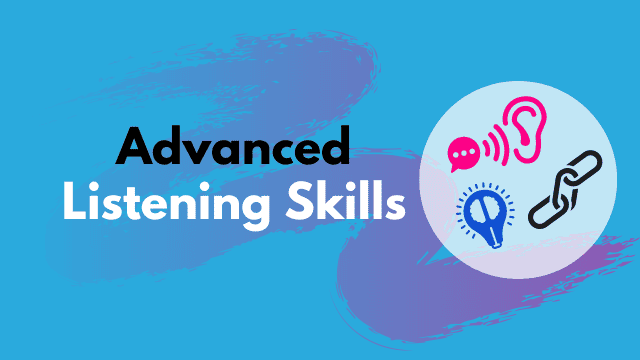Advanced Listening Skills for Leaders
Transform Your Leadership Through the Power of Active Listening
"The most basic of all human needs is the need to understand and be understood. The best way to understand people is to listen to them." — Ralph Nichols
Why Listening Is Your Most Powerful Leadership Tool
In a world where leaders are often celebrated for their vision, decisiveness, and ability to communicate persuasively, one critical skill is frequently overlooked: listening. Yet, research consistently shows that leaders who excel at listening create more engaged teams, foster innovation, and build stronger organizational cultures.
Advanced listening goes far beyond simply hearing words. It's about creating a space where ideas can flourish, where team members feel valued, and where genuine understanding can take place. For leaders facing complex challenges in today's fast-paced business environment, mastering advanced listening skills isn't just beneficial—it's essential.
Enhanced Team Engagement
Teams led by active listeners report 23% higher engagement scores and 18% lower turnover rates.
Improved Decision Making
Leaders who practice deep listening make more informed decisions by capturing diverse perspectives.
Stronger Relationships
Active listening builds trust and psychological safety, creating stronger professional relationships.
The Five Levels of Listening for Leaders
Not all listening is created equal. As a leader, understanding the different levels of listening can help you consciously elevate your practice and reap greater benefits.
-
Level 1: Ignored Listening
At this level, you're physically present but mentally elsewhere. Your thoughts are on other matters, and you're simply waiting for your turn to speak. This is the most damaging form of listening for leaders as it communicates disrespect and disinterest.
-
Level 2: Pretend Listening
Here, you feign attention while mentally preparing your response. You might nod and make appropriate sounds, but you're not truly processing what's being said. Team members can usually detect this inauthentic engagement.
-
Level 3: Selective Listening
At this level, you hear parts of the message but filter information based on your existing beliefs or what you find interesting. You miss crucial context and nuance that could inform better leadership decisions.
-
Level 4: Active Listening
Now we enter productive listening territory. Active listening involves full concentration, understanding, responding, and remembering. You make a conscious effort to hear not just the words but the complete message being communicated.
-
Level 5: Empathic Listening
The highest form of listening, empathic listening means understanding with both the heart and mind. You temporarily step into the speaker's world, sensing their emotions and perspective. This creates profound connection and insight.
Practical Techniques to Elevate Your Listening Skills
Eliminate Distractions
Put away your phone, close your laptop, and give your full attention. Create an environment where deep listening can take place by removing physical and mental distractions.
Practice the 80/20 Rule
Aim to listen 80% of the time and speak only 20% of the time in conversations. This ratio ensures you're gathering more information than you're giving out.
Master the Art of Questioning
Use open-ended questions that start with "what" or "how" to encourage deeper sharing. Follow up with clarifying questions that demonstrate your engagement with the topic.
Embrace the Pause
Resist the urge to immediately fill silences. Allowing pauses gives both you and the speaker time to process information and often leads to more thoughtful exchanges.
Reflect and Summarize
Periodically paraphrase what you've heard to confirm understanding: "So what I'm hearing is..." This technique validates the speaker and ensures accurate comprehension.
Overcoming Common Listening Barriers for Leaders
Even with the best intentions, leaders face specific challenges that can impede effective listening. Recognizing these barriers is the first step to overcoming them:
The Status Barrier
As leaders rise in an organization, team members may become reluctant to speak candidly. Create psychological safety by explicitly inviting honest feedback and demonstrating that you value diverse perspectives.
The Time Pressure Barrier
Leaders often feel too busy to listen deeply. Schedule dedicated "listening time" in your calendar and communicate that these periods are protected for uninterrupted conversation.
The Solution Bias Barrier
Many leaders instinctively jump to providing solutions rather than deeply understanding the problem. Practice asking "What else?" three times before offering any solution.
The Cognitive Load Barrier
When overwhelmed with information, your listening capacity diminishes. Manage your cognitive load by taking brief notes, practicing mindfulness, and scheduling important conversations during your peak mental hours.
Listening Across Different Communication Styles
Effective leaders adapt their listening approach based on different communication styles they encounter:
| Communication Style | Characteristics | How to Listen Effectively |
|---|---|---|
| Analytical | Detail-oriented, fact-based, methodical | Listen for data points and logical structure. Ask clarifying questions about methodology and assumptions. |
| Intuitive | Big-picture focused, future-oriented, conceptual | Listen for themes and patterns. Help connect concepts to practical applications. |
| Functional | Process-focused, sequential, procedural | Listen for steps and timelines. Ask about implementation details and required resources. |
| Personal | Emotional, values-based, relationship-oriented | Listen for feelings and values behind the words. Acknowledge emotions before moving to solutions. |
Case Study: Listening Leadership in Action
How one executive transformed team performance through advanced listening
When Sarah became the new director of a struggling product development team, she found low morale and missed deadlines. Rather than immediately implementing changes, she spent her first month in "listening mode."
Sarah scheduled one-on-one conversations with each team member, practicing empathic listening. She asked open-ended questions: "What's working well?" "What obstacles are you facing?" "If you could change one thing, what would it be?"
Through deep listening, Sarah discovered that the team's previous leader had imposed processes that worked against their creative workflow. Team members had innovative solutions but felt unheard. By implementing changes based directly on what she learned through listening, Sarah's team increased productivity by 34% in the following quarter and employee satisfaction scores rose from 65% to 89%.
The key wasn't just that Sarah listened—it was how she listened. She removed distractions, maintained eye contact, asked follow-up questions, and summarized what she heard to confirm understanding. Most importantly, she acted on the insights gained, demonstrating that listening was not just a technique but a cornerstone of her leadership philosophy.
Implementing a Listening Culture in Your Organization
As a leader, your listening behaviors set the tone for your entire team or organization. Here's how to scale the impact of advanced listening skills:
- Model the behavior: Demonstrate active listening in meetings, one-on-ones, and casual interactions. Your team will notice and begin to mirror your approach.
- Create listening rituals: Implement structured opportunities for listening, such as monthly "listening circles" where team members can share ideas in a facilitated environment.
- Reward good listening: Recognize and celebrate instances when team members demonstrate exceptional listening skills that lead to positive outcomes.
- Train your team: Invest in professional development focused on communication skills, including advanced listening techniques.
- Measure listening impact: Include questions about listening effectiveness in your engagement surveys and leadership assessments.
Frequently Asked Questions
How can I improve my listening skills when I'm constantly interrupted?
Create boundaries around your listening time. Let colleagues know when you're in "deep listening mode" and when you're available for quick questions. Use visual cues like closing your door or wearing headphones to signal when you need uninterrupted focus.
What's the best way to listen in virtual meetings?
Turn on your camera to provide visual feedback, minimize distractions by closing other tabs, take notes to stay engaged, and use the chat feature to acknowledge points without interrupting the speaker. Schedule breaks between virtual meetings to prevent listening fatigue.
How can I tell if my listening skills are improving?
Look for these indicators: people seek you out for conversations, you're receiving more nuanced information, your team members seem more open with you, you're making fewer assumptions, and you're surprised more often by what you learn.
Is there a downside to listening too much as a leader?
While rare, over-listening without action can create frustration. Balance deep listening with clear decision-making and follow-through. Communicate when you're in information-gathering mode versus when you're ready to make decisions.
Develop Your Advanced Listening Skills with Al Mithaq Institute
Ready to transform your leadership effectiveness through advanced listening skills? Al Mithaq Institute offers specialized leadership communication programs designed for busy professionals.
Explore Our Leadership ProgramsConclusion: The Listening Leader's Advantage
In a business world that often celebrates the loudest voices, leaders who master the art of listening gain a significant competitive advantage. By creating space for others to be heard, you access diverse perspectives, build stronger relationships, and make more informed decisions.
Advanced listening isn't just a skill—it's a leadership philosophy that recognizes the wisdom that exists within your team. When you truly listen, you communicate respect, build trust, and create an environment where innovation and engagement can flourish.
As you implement the techniques discussed in this article, remember that becoming a better listener is an ongoing journey. Each conversation is an opportunity to practice and refine your skills. The investment you make in developing advanced listening capabilities will pay dividends throughout your leadership career.
Your next leadership breakthrough might not come from what you say, but from what you hear when you truly listen.







